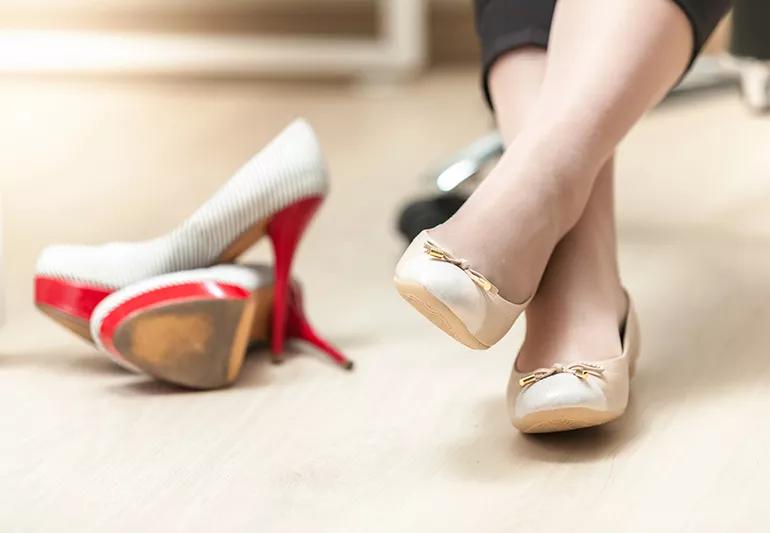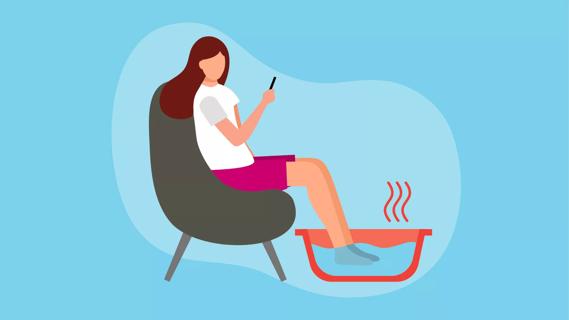A tear in the stabilizing structure under your foot is a common cause

Pain in the ball of the foot and swelling on top of the foot are symptoms of a condition that’s both common and often misdiagnosed. The condition — called a plantar plate tear — can happen either suddenly or as a result of chronic, repetitive stress over time.
Advertisement
Cleveland Clinic is a non-profit academic medical center. Advertising on our site helps support our mission. We do not endorse non-Cleveland Clinic products or services. Policy
The plantar plate is a fibrous structure under your foot that supports and stabilizes the joints between the toe bones and the bones of the foot. (These are the metatarsophalangeal joints).
Made up of collagen, the plantar plate consists of bands that provide attachments for ligaments that go to each toe and that go between toes. These keep your toes straight (preventing them from drifting up) and also in alignment (preventing them from separating).
“The plantar plate is implicated in forefoot pain much of the time,” says podiatrist Georgeanne Botek, DPM.
There are 3 causes of plantar plate tears, Dr. Botek says:
Structural. A bunion or crossover deformity (when one toe crosses over the one next to it) can put added pressure under the foot.
Traumatic. “A plantar plate can tear from an injury, like tripping over a dog’s leash or your are running and all of a sudden you feel a sharp, shock-like, stabbing sensation across the ball of the foot,” Dr. Botek says.
Chronic, repetitive stress. With age, the plantar plate can wear down and be susceptible to tearing. Any active adult (usually over age 45) can have a plantar plate tear. But people who spend a lot of time on the balls of their feet (think: working on ladders or wearing high heels) and those who bend their toes a lot are susceptible.
The most common site for a plantar plate tear is under the second toe, but it can happen under any toe.
Even though plantar plate tears are common, they aren’t always recognized. “It’s not unusual for someone to go many months and not realize this is the source of their pain,” Dr. Botek says.
Advertisement
A plantar plate may be misdiagnosed as:
Plantar plate tears are diagnosed with a physical exam, medical history and X-rays. An MRI or ultrasound may also be used.
Treatment involves placing and holding the affected toe in a position that allows the tear to heal. “I flex the toe 10 degrees, bringing it lower than the adjacent toe, so the edges of the torn plantar plate come together. Then, I crisscross tape along the bottom of the foot to hold the toe down,” Dr. Botek explains.
There are also splints that can be used to hold the toe in this position. It typically takes three to six months to heal. Dr. Botek advises patients to wear stiff-soled shoes and shoe inserts with metatarsal pads.
If these measures don’t help or if a deformity has already formed, surgery is an option. It’s often done in conjunction with surgery for other foot deformities.
Advertisement
Learn more about our editorial process.
Advertisement

Try seated and standing exercises to help lengthen and strengthen the muscles that support your plantar fascia

Home remedies are unlikely to cure your contagious foot fungus — and they might even make it worse

Cramps can creep up if your shoes are too tight, you’re dehydrated or you have poor circulation

If soaking your feet, disinfecting your shoes and making lifestyle changes don’t do the job, it’s time to talk to a doctor

Genetics, hormones, medications and stress are just a few reasons your feet could be extra funky

Try stretching, massage, elevation and a supportive pair of shoes to help relieve foot aches and pains

Footwear that offers cushioning plus heel and arch support can help you relieve and manage symptoms

Except in certain medical scenarios, foot health experts rarely recommend foot soaks

Babies can get congested easily, but you can calm their cough by keeping them hydrated, using nasal drops and running a humidifier

Weight loss may cause loose, sagging skin and muscle loss to your rear

Several conditions, like vitiligo and fungal infection, can cause a loss of pigmentation, leading to white spots or patches on your skin